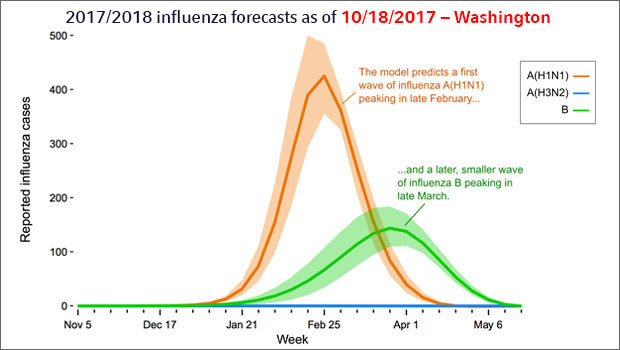KPWHRI begins new phase of flu surveillance

KPWHRI receives $10 million to continue vaccine effectiveness research for flu, COVID-19, and other respiratory diseases
At the end of September, Kaiser Permanente Washington Health Research Institute (KPWHRI) began the first year of another 5-year span as one of the study sites in the U.S. Influenza Vaccine Effectiveness (Flu VE) network, housed at the CDC (Centers for Disease Control and Prevention).
“It’s especially important to have good surveillance when we have this overlap of influenza and COVID-19,” said KPWHRI Associate Investigator Karen Wernli, PhD, the principal investigator on the project. “The past 2 flu seasons were very quiet, and we still don’t know how the seasonality of flu might be impacted by the presence of this other very transmissible respiratory virus. So, the next 5 years of data are very important for informing ideal vaccination timing and development of new vaccines, among other things.”
The network provides estimates of clinical effectiveness of licensed flu vaccines, broken down by age group and type of influenza — crucial information for understanding influenza’s impact each year and planning for future flu seasons.
The grant, for $10 million over the 5-year period, supports enrollment of Kaiser Permanente Washington members in the surveillance study, collection of specimens, and reporting data back to the CDC.
KPWHRI’s participation in the Flu VE network began during the 2011-2012 flu season. Since then, the team has enrolled around 21,000 study participants, collected 22,000 specimens, and published more than 45 peer-reviewed papers on their work. Since the pandemic began, they have also been studying the effectiveness of COVID-19 vaccines. As a testament to the dynamic nature of this team, KPWHRI was the first site to pivot from in-clinic to phone recruitment and self-swabs for testing as a result of telehealth appointments when the pandemic began. The team is also highly committed to this work, with most team members working on this study for several years, over multiple funding cycles, and through the pandemic.
Improving and adapting
This year, the grant includes a new aim — to study a change in methods that could make the results of surveillance more accurate and precise. Called 2-phase sampling, it’s something that Wernli has experience with in her work as a cancer epidemiologist.
“What we are trying to do is mathematically account for differences in the characteristics of the people who seek care for illness and those who do not, so that our results are more likely to be accurate for the general population,” she explained. “We want to make sure that the data we get is as useful as possible, especially since participation in vaccination and care-seeking behavior is changing. This is one way to achieve that.”
If successful, the new method would improve the precision of the estimates and make it possible for researchers to better understand vaccine effectiveness in subgroups of the general population and disparities between different groups. Wernli will work with KPWHRI Biostatistics Investigator Brian Williamson, PhD, on this component of the study.
How does the study work?
The study enrolls about 1,200 people each flu season. Kaiser Permanente Washington members ages 6 months and older who have symptoms of an acute respiratory illness like flu or COVID-19 can be enrolled in the study. Participants will provide nose/throat swabs to be tested for the viruses that cause the flu and COVID-19 and can also provide a finger-prick blood spot to test for prior infection. It is possible that, in later years of the project, the team will test for other respiratory viruses.
In addition to laboratory test data, the researchers will look at electronic health record data to understand patterns in how flu, COVID-19, and other viruses might be impacting different age groups. The health records include information on social determinants of health, such as number of household members, socioeconomic status, and whether members live in an urban, rural, or suburban area.
“The COVID-19 pandemic highlighted many disparities across the population in who was most impacted,” said Wernli. “Including these social determinants of health measures in our study can help us understand what factors might influence these disparities, and what approaches could be used to counteract them.”
Kaiser Permanente Washington members who participate in the study are part of a nationwide cohort helping provide vital information to policymakers and the public about the trajectory of the flu season and effectiveness of the vaccine.
“We also have clinical partners who make this work possible,” said Wernli. “Without their expertise and input, we wouldn’t be able to do this project on such a large scale.”
She highlighted the contributions of Kaiser Permanente Washington’s Director of Urgent Care Service Line Victor Garcia and Senior Medical Director of Specialty Care Barbara Detering, MD, who provide input on the project and help to develop effective processes for working with participants in urgent care clinics.
Where can you track this year’s flu season?
There are different places that the public can get information on the flu season in Washington state. Kaiser Permanente provides basic information about the flu on their website, as well as COVID-19 information for each region.
The Washington State Department of Health publishes data on COVID-19 and influenza. This is a good place to look for current activity levels of both illnesses, as well as general information.
By Amelia Apfel
Coresearcher
Brian D. Williamson, PhD
Associate Biostatistics Investigator
Kaiser Permanente Washington Health Research Institute
vaccines

Flu shots boost your chances of staying well
While flu vaccine effectiveness varies year to year, it still makes sense to get immunized annually.
Research

Flu season is winding down – What did we learn?
Dr. Michael Jackson gives a late-season report on state and national influenza patterns and his Flucaster prediction model.



